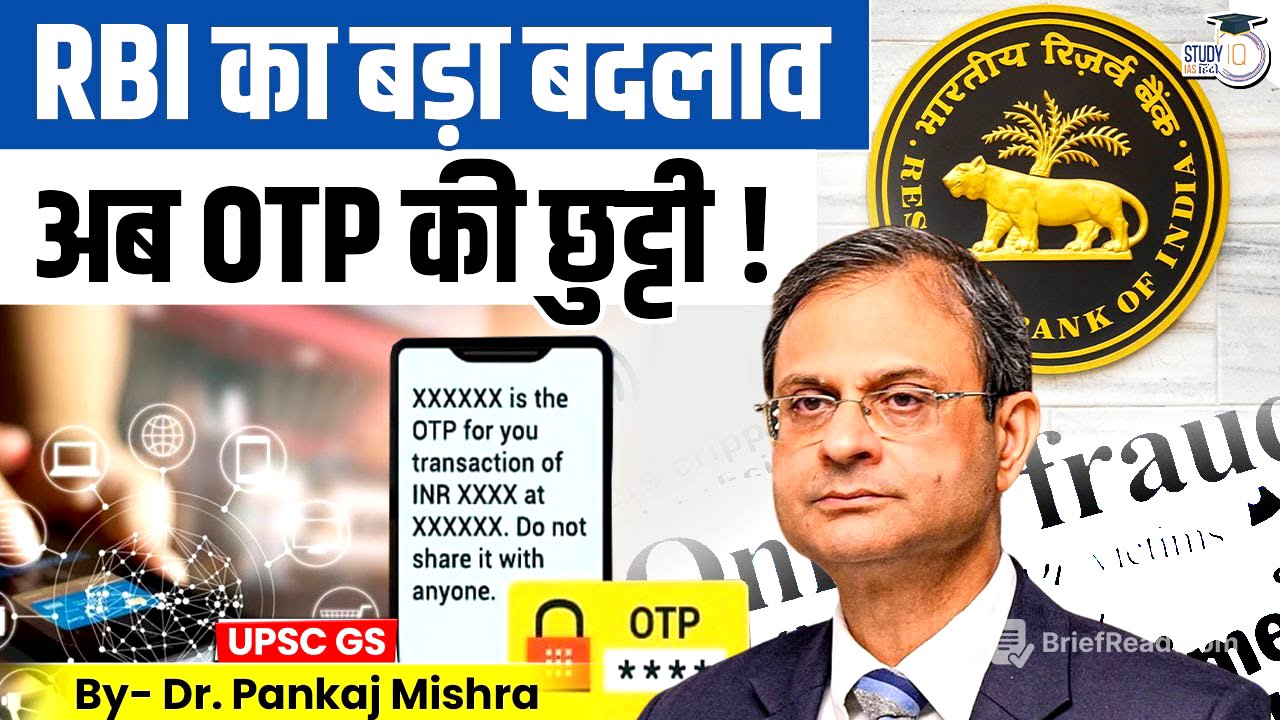TLDR;
This video discusses the Reserve Bank of India's (RBI) new directives to replace OTP-based digital payment authentication with more secure methods like biometrics and AI-driven fraud detection by April 1, 2026. It addresses the increasing digital fraud issues, including SIM swap fraud and phishing, and the limitations of the OTP system, such as delays and failures. The video also explores global practices in digital payment security, such as those in the European Union, Singapore, and America, and highlights the potential benefits and challenges of the new system in India, including enhanced security, convenience, and innovation, as well as concerns about the digital divide, privacy, implementation costs, and accessibility.
- RBI is set to replace OTP-based authentication with enhanced security measures by 2026.
- The move aims to combat rising digital fraud incidents like SIM swapping and phishing.
- New authentication methods will include biometric verification, AI-driven fraud detection, and device binding.
Introduction: Digital Payments and the Rise of Fraud [0:08]
The video begins by highlighting the widespread use of digital payments in India, especially after the UPI revolution. However, this increase in digital transactions has been accompanied by a rapid rise in digital fraud. To address this growing problem, the Reserve Bank of India (RBI) has issued new directives and guidelines for One-Time Passwords (OTPs) and is set to implement a new authentication mechanism for digital payment transactions.
The OTP System and Its Vulnerabilities [0:36]
The presenter explains that until now, the security for digital transactions relied heavily on OTPs, which are typically five- or six-digit codes sent to users to complete their transactions. However, fraudsters have found ways to misuse this system, such as through SIM swap fraud, where they port a user's mobile number to their name, allowing them to receive the OTP. Additionally, phishing and social engineering tactics are used to trick individuals into revealing their OTPs. The presenter also notes that OTP delays and failures can cause significant inconvenience and transaction disruptions.
RBI's Decision: Moving Beyond OTP [0:03]
The RBI has decided to implement new authentication systems in place of OTPs, effective from April 1, 2026. These new systems will include biometric authentication (fingerprint or iris scanning), face recognition technology verified by AI, device binding (allowing users to approve or reject transactions directly on their mobile app), token generation for dynamic codes, and AI-driven fraud detection for high-risk transactions. The goal is to abolish the monopoly of OTPs and adopt additional security measures to strengthen the authentication process.
Benefits of the New Authentication System [0:03]
The new authentication system is expected to strengthen security by making it more difficult to steal biometric data or face IDs compared to OTPs. It will also increase convenience by eliminating the need to type digits repeatedly and speed up transactions through instant approval. Additionally, it will foster innovation by providing opportunities for fintech companies to develop new models and markets.
Challenges and Concerns [0:04]
The presenter identifies several challenges associated with the new system. The digital divide could pose a significant obstacle, as individuals in rural areas may not have the necessary technology or knowledge to use biometrics or smartphones for transactions. Privacy concerns arise from the potential leakage of biometric data, which could have permanent consequences. The implementation cost will be high, requiring banks to upgrade their infrastructure. Accessibility issues may also occur if biometric systems or face recognition technology malfunctions, potentially stranding users.
Global Practices in Digital Payment Security [0:05]
The video explores practices in other countries. In the European Union, the Payment System Directive 2 (PSD2) has been in effect since 2018, requiring strong customer authentication that includes knowledge factors (password or PIN), procession factors (device or token), and inherence factors (fingerprint or face recognition). Singapore uses the Singh Pass ecosystem, a centralized digital identity system that allows citizens to access banking and government services through biometric or token-based login. In America, many banks generate hardware tokens and use app-based authentication to reduce fraud.
Conclusion: A Historic Step Towards Enhanced Digital Security [0:07]
The presenter concludes that the RBI's decision to move beyond OTPs is a symbolic and historic step towards a structural transformation in the digital security ecosystem. By implementing multi-factor authentication, financial transactions will become more secure, reducing the chances of fraud. The presenter then poses a question to the audience, asking whether they believe biometric authentication is more secure than OTPs, and encourages them to share their opinions in the comments.
